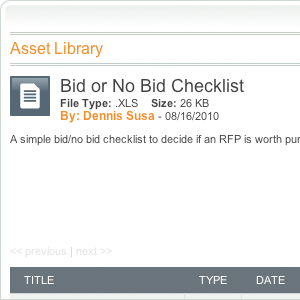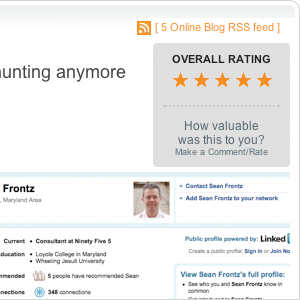Two years ago, I had just written a blog post appreciating the design and content strategy for Cadence Design Systems’s website, when Tom Diederich, Community Manager at Cadence, noticed it and left a comment. From there, Tom and I connected and eventually set up an interview to get to know each other better and for me to learn what he was up to at Cadence. Just recently, Tom answered a question I asked on LinkedIn, so I thought now was a good time to check back in with him…

“A reputation system is the key to making any online community…successful.“
– Tom Diederich, Community Manager, 5 Online
When I last checked in with you—just over two years ago now—you’d just launched an online community for Cadence Design Systems. I know you’ve been pretty busy since then. Catch me up on what you’ve been up to.
Quite a lot has happened since then. Cadence’s community surpassed 150,000 members recently and continues to be vibrant. After I left Cadence I joined social media vendor Lithium Technologies as a member of the client services group.
My team worked with dozens of Lithium customers—HP, RIM, Virgin Media, Best Buy, Barnes and Noble, to name but a few—helping them do the same thing I did at Cadence and Symantec: Build successful user communities and blog programs.
I currently hang my hat at a cool company called Ninety Five 5. We just launched our first user community on August 6th, called “5 Online.” It’s dedicated to sales professionals and features peer-to-peer forums, expert blogs, live online events, news, groups, an asset
library, and more!
Having a rich online community like the one you’ve built for 5 Online makes obvious sense for a company that provides enterprise sales training. It’s like a continually growing proof of concept for many training materials and techniques, as well as probably the overall experience of training. But how would an online community benefit a company that doesn’t stand to make money directly from their content strategy?
Obviously we want to make money—like any business. But we didn’t build the community to do just that. Our brand name isn’t widely known outside our core clients—Dell, Acxiom, Invensys to name but a few. So one goal is to make Ninety Five 5 a “household” name, if you will, among sales professionals.
Providing a home to discussions on topics of interest to B2B and B2C sales professionals will naturally create awareness of who we are, even if some or most of those visiting or using the community aren’t our clients. It will also shoot us up in the search results on Bing, Google and Yahoo—search engines love websites that are constantly updated, such as online communities.
Naturally our hope is that most visitors will not only join the community—which is free—but will also decide to subscribe to our Sales Success System (S3), which is $39 a month.
That may sound cheesy, but when you look at top-performing sales professionals, and you actually talk with them, you’ll discover that they’ve all got a system. If you don’t have your
own system, we’ve built one. Our system is tried and true, and whether you’re a novice or an expert, this system is proven to work.
But regardless of whether they subscribe or not, the community is free and will always be
there to help them be the best they can be.


What are some of your favorite features of the 5 Online community?
In addition to the forums and blogs, I must say I’m a fan of the Library. It’s a place where anyone can share PowerPoints, Word docs, templates, etc. I’m a big fan of the live, online events—very impressive. All are free, too, by the way.
I also love the look and feel of the community from an aesthetic perspective. If you haven’t created a free account, please do because the entire look and feel changes when you log in—you suddenly gain access to a richer set of free content in terms of news and features and limited access to S3. It’s pretty slick.
I’d love to get a bit of a behind-the-scenes look at the development process for 5 Online. What part of that process are you most proud of? What was the most challenging aspect of
building this new site?
I’m not an IT guy, so I wasn’t in there messing about with code or system integrations—nothing like that. I’m sure the part of the team that worked on the nuts and bolts would also have quite a story to tell.
But from my perspective as community manager, the most challenging part has been getting the functionality I want into the forums and blogs. We’re getting there, though, and that is exciting.
In that regard, the part I’m personally proudest of is how I helped shape the look, feel and functionality of the blogs and forums, and how I’m now helping to drive the future functionality of them. They aren’t where I want them to be yet, as I mentioned, but the development team is
already working on version 2.0. For example, I really want to incorporate roles and ranks, along with a rich text editor.
Even two years after launching, I still point to Cadence as a great example of an effective web content strategy for business-to-business sites. The blog content is diverse and the bloggers prolific. But after reviewing the last few months of content, I noticed that they’re still having trouble building engagement. What have you done differently since Cadence —either with 5 Online or elsewhere—to encourage user engagement?
Since Cadence, I’ve learned how to create online brand presences across multiple social media sites, namely LinkedIn, Twitter and Facebook. I learned that even though someone is a fan of your brand, product or service, they don’t always think to visit your website all that often.
However, they are on Facebook, Twitter and LinkedIn nearly every day—if not many
times a day. So these are the places to interact your community members—and to recruit
new members—to let them know that something new and of interest is now waiting for them back on your site.
It’s like driving down the highway in a new town and seeing a billboard that grabs your attention. You notice that your favorite restaurant is at the next exit, so you take the off-
ramp and roll into their parking lot. If that sign hadn’t been there, you would have driven right past.
I really like the rating functionality that you’ve built into the community content. It’s so simple, but it makes providing real feedback easy and helps to encourage a real sense of participation among those involved. I first noticed something like this on BoxesandArrows.com, where you can rate content and other users’ comments. Eventually, the amount of comments and “thumbs up” from other users begins to build your “reputation” by rating you in a points system. So far, I’ve found this kind of thing to be good, but I could also see how it might encourage the wrong kind of participation. What are your thoughts on incentivizing engagement?
That’s a great question. A reputation system is the key to making any online community “addictive.” And addictive equals successful. Sure, you also need lots of other things—a well-managed “superuser” program, the right board structure, along with the right kinds of promotion—but the reputation system is a must-have, too.

This model was probably born in the videogame industry. For example, the Call of Duty games that are so popular now on Xbox, PS3, PCs and even the Wii. For the online part, like so many of these games, you start as a “Private” and rank up—to Corporal, Sergeant, etc.—as you meet pre-defined objectives.
It’s the same for the members of online communities. If you make the ranking structure fun, creative and increasingly challenging to rank up the higher they go—I prefer not to use military themes—then it makes active participation competitive and addictive. Members who want to “rank up” and surpass other members will have to participate more and in new ways the higher up they go in the ranking hierarchy.
I’m also a fan of the “thumbs up” option for content. That said, I’m not a fan of the “thumbs-down” option or the 1-5 star rating feature—which, ironically, we have at the moment on our community but we’re working to replace it with the “thumbs-up” only. Why? You’ll always get a few bad eggs who give everything a “thumbs-down” or a “1-star” just to be mean. And because folks who probably like the content don’t bother with rating it at all, the appearance is that the post, comment, or what have you, wasn’t appreciated or valued by the community—in fact it wasn’t “liked” at all. This sort of thing can really turn off the person who went to all the trouble to post. And some of those people might even be a potential superuser. That’s why I always recommend the “thumbs-up” only option—no “thumbs-down,” just positive-only ratings.
One thing I would warn anyone to avoid is implementing a points-for-prizes or cash rewards
system. These can only bring pain by way of abuse. It’s fine to have contests and even give out chotchkes from time to time—even flying superusers out to an annual event is OK. But to actually pay for contributions would grow the wrong kind of community and culture.
What’s next for online communities? What will be different for sites like 5 Online five years from now, and what will be the same?
I think we’ll see the majority of online communities offering members the option of connecting to them in new ways and from new devices. Undoubtedly many more individuals will be interacting with their online communities via mobile devices—smartphones more than likely—but also from their network of web-enabled devices—TV’s, cars, perhaps even the refrigerator. And they’ll connect in new ways to peer-to-peer and support communities. Sometimes accessing past content, other times connecting directly for live interactions. For example:
- Real-time video: “My Maytag washing machine is making a funny noise—listen. This dial is loose, too. I’ll run the diagnostic and show you what’s happening.”
- Voice via phone or car radio: “Hey everyone, I’m trapped in Cleveland for business
this week and don’t know where to get a decent cappuccino! Anyone have a recommendation?” - And perhaps even from videogame-like interfaces where the person enters a pseudo- virtual world—this is more likely for online training and gaming.
Ahh, I’m really interested in the future of web-enabled devices. This is something I wrote about last year in an article on the future of the web, as well as last fall in an article for Smashing Magazine on Holistic Web Browsing, only I called them “web-enhanced devices.”
I also think companies will see a clearer ROI for communities—mainly because the measurement tools will be more mature and standardized compared with the mishmash we see today all based on competing rules and algorithms. But the conversations, friendships, rivalries will all be the same. That will never change.
Ok, one last thing: Last time we talked, I asked you what you’d do if society had to “reboot” after some kind of collapse. You said you’d get your hands on a printing-press and do some good old-fashioned publishing to build literacy. Still sound good to you?
Yes indeed. When it comes down to it, that’s what online communities—and really
everything we use most of the technologies we have around today—are for: Information. And it all started with the printing press. Good ol’ Johannes Gutenberg must be smiling down on
us right about now.
I hope so! Tom, thanks again for spending some time with me and a great conversation.
You can connect with Tom at the 5 Online community and also by following him on Twitter.



